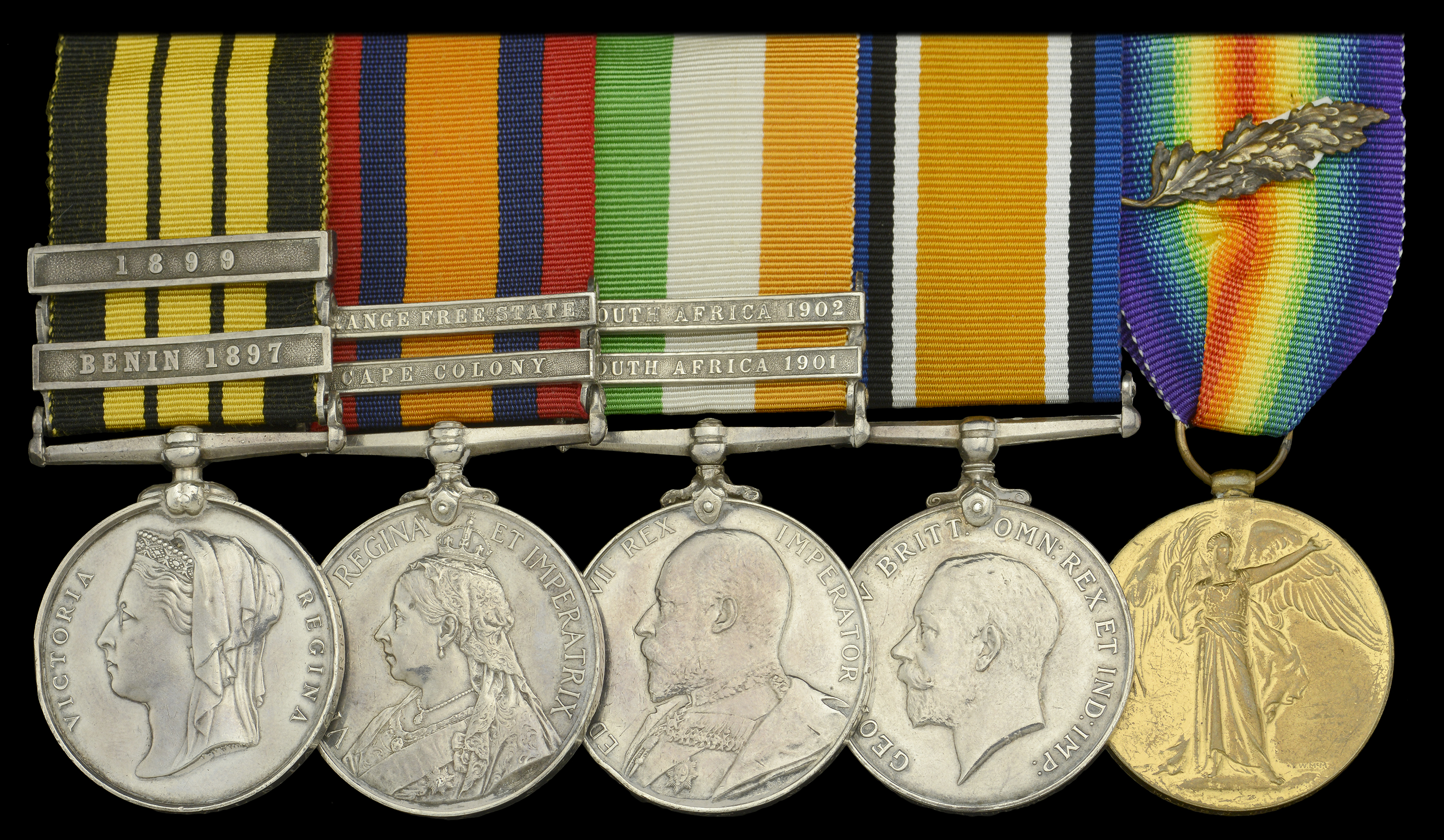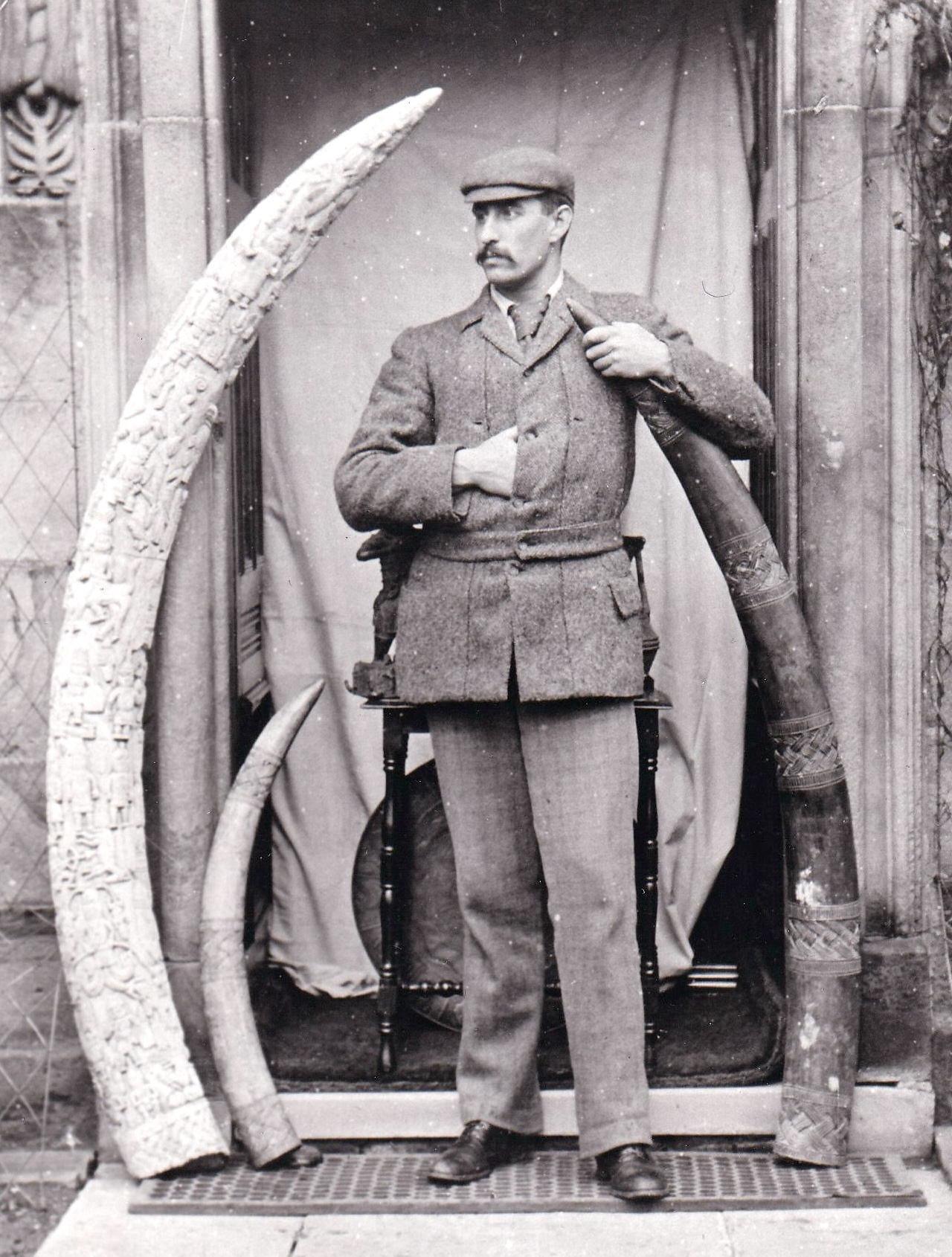A rare ‘Benin operations’ group of five awarded to Major N. Burrows, South Wales Borderers, late Loyal North Lancashire Regiment, attached Niger Coast Protectorate, who served as a volunteer in the Benin operations of both 1897 and 1899, being three times Mentioned in Despatches East and West Africa 1887-1900, 2 clasps, Benin 1897, 1899 (Lieut. N. Burrows, Loyal N. Lancs. Regt.); Queen's South Africa 1899-1902, 2 clasps, Cape Colony, Orange Free State (Major N. Burrows, S. Wales Bord.) engraved naming; King's South Africa 1901-02, 2 clasps, South Africa 1901, South Africa 1902 (Major N. Burrows, S. Wales Bord.) engraved naming; British War and Victory Medals with M.I.D. oak leaves (Major N. Burrows) minor edge bruising, polished, good very fine, the Benin 1897 clasp extremely rare to British officers (5) £700-£900 --- Norman Burrows was born on 15 October 1868 and was educated at Sedbergh School. Commissioned Second Lieutenant from the Militia in the Loyal North Lancashire Regiment in January 1891, he embarked with the 1st Battalion for India and was promoted Lieutenant in October 1892; he was fortunate to emerge unscathed from the 'Nagpur Railway Disaster' in November 1891, when 11 men from the Battalion were killed. Appointed an Acting Vice-Consul in the Niger Coast Protectorate in February 1895, Burrows undertook administrative and judicial duties over a very large area. He also performed good work in the Benin operations of 1897, when, as a Volunteer in the Niger Coast Protectorate Force, he came to the notice of Rear-Admiral Harry Rawson for reconnaissance work:
‘Captain Burrows, who, with Captain Cockburn, ascertained the nature of the country between Ceri and Ologbo Beach, on both sides of the creek’ (London Gazette 7 May 1897). A fuller account of that valuable work was reported by Lieutenant-Colonel Bruce Hamilton:
‘I take this opportunity of mentioning here the very excellent work done by Messrs. Burrows and Lyon in this district during a most trying and anxious time. They have both acted with great energy and tact in most difficult circumstances. Mr. Burrows has done most useful work in surveying the water approaches to Ikuru and Ologbo. Before I arrived, and a few days after the facts of the expedition were known, he took a few men with him and burnt Ologbo.’ As Rear-Admiral Rawson's force closed the outskirts of Benin in February 1897, Burrows was again cited for his good work by Hamilton:
‘Captain Burrows, who worked the leading Maxim throughout most creditably and was often in positions of considerable danger’ (London Gazette 7 May 1897). Specially promoted to Captain in the South Wales Borderers and given a Brevet Majority, Burrows returned to his administrative and judicial duties, and having been appointed a District Commissioner in 1898, was actively engaged in the Ologbo Sheri operations in 1899, when he was Mentioned in Despatches for a third time, for his 'exceptional zeal' as a column leader, and for undertaking risks which his position did not require him to take (London Gazette 14 September 1900). An illustration of the risks that Burrows undertook may be found in a report he submitted concerning an operation he mounted against an enemy camp near Obuiho on 4 May 1899: ‘Taking 12 men, I myself proceeded in search of one of the enemy's camps, which I found to be close to the town. I surprised the camp, and after having one shot, which wounded a man, reported to Obohun's headman. I rushed in and captured two other men, six guns and a pistol. The remaining three who were in the camp and got away, were afterwards brought in’ Burrows relinquished his position in late 1899, the outbreak of the Boer War necessitating his deployment as a District Commandant. He served in South Africa in that capacity until September 1902, at Queenstown, Burghersdorp, Modder River and Boshof (Queen’s South Africa Medal and 2 clasps; and King's South Africa Medal and 2 clasps). Following a period of leave, he returned to South Africa in 1903, as a Special Commissioner on the Compensation Board. Returning to the U.K., he was attached to the Army Service Corps from 1904 to 1906, before being appointed Adjutant of the 1st (Volunteer) Battalion, Border Regiment, in April 1906. Placed on the Retired List in May 1909, Burrows took up the office of Deputy Governor of H.M. Prison Pentonville. The prison had taken over the role as north London's execution centre on the closure of Newgate in 1902, as well as being a training centre for future executioners. In consequence, in his term of office from May 1909 until the outbreak of the Great War, Burrows would have witnessed the execution of several notorious murderers, all carried out by Chief Executioner John Ellis, among them Dr. Hawley Crippen and Frederick Seddon. Whilst at Pentonville he made an unsuccessful application for the post of Chief Constable of West Sussex. Following the outbreak of hostilities in August 1914, Burrows was appointed to the command of the 7th Battalion, Loyal North Lancashire Regiment, in which capacity he served until taking up duty as a Railway Transport Officer, graded as Staff Captain, in May 1915. Advanced to Major in September of the same year, he subsequently served as Assistant Provost Marshal to 62nd Division from March to August 1916, before transferring to the 3rd Battalion, South Wales Borderers. Placed on the Reserve of Officers in July 1919, he was appointed Governor of H.M. Prison Wakefield, and died in October 1922. Sold with various photographic images and a large file of copied research, including medal roll extracts, official correspondence and reports; together with a host of glowing testimonials submitted on his application for the post of Chief Constable of West Sussex in the summer of 1912.









